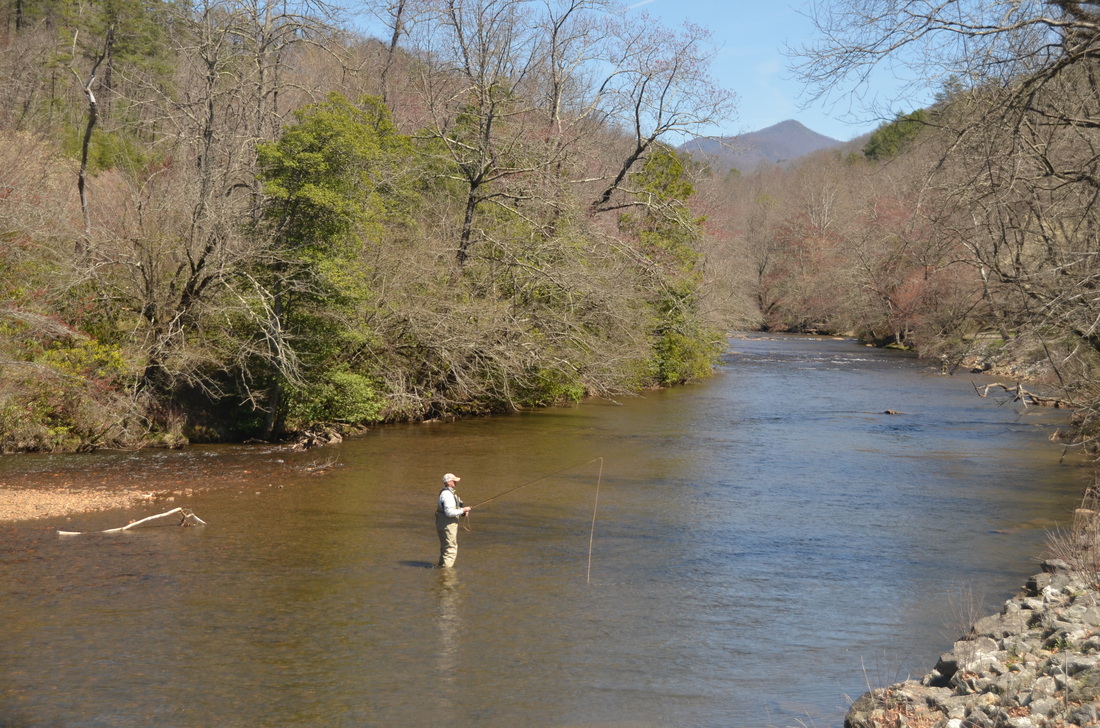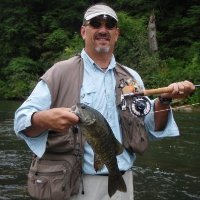|
The WNC Fly Fishing Trail was created in the Winter of 2008-09. The first trail maps were printed and distributed in February of 2009. Since that time over 160,000 maps have been printed and given to anglers across the nation. If anyone would like a copy of the map, or trail information, you can contact Alex Bell at AB's Fly Fishing Guide Service, alex@abfish.org or go to www.abfish.org, or to the trail website at www.flyfishingtrail.com. You can also visit www.mountainlovers.com or call 800.962.1911, or 828.226.3833, for a list of accommodations.
The trail consists of 15 spots throughout Jackson County and the Cherokee Indian Reservation. This report, and those to follow, will combine some of the small streams, delayed harvest section of the Tuckasegee River, and the trophy section on Raven's Fork in Cherokee. Delayed Harvest Waters were stocked the second time in 2016 the first week of April. Small Streams: First and foremost, all 'Hatchery Supported Waters' re-open Saturday, April 2. at 7:00AM. Please visit www.ncwildlife.org to get the official dates of closing/opening fishing dates. April starts the fabulous trout fishing season of Spring. Dark fly are still prevalent early in the month and then transitions into lighter colors towards the end of the month. As with most cases, water temps dictate insect hatch activities. Low to mid 50 degree water temps usually initiate more activity. The dark fly's can be matched by Blue Wing Olive, Blue Quills, and Quill Gordons. Little Black Caddis and March Brown's can be a good producers. Later in the month as lighter colored mayflies start appearing, the use of Light Cahills, Elk Hair Caddis, and on the warmest of days, Yellow Sallies will start appearing. When adding a dropper, Pheasant tail nymphs, bead head Hare's ears, little rubber legged bead head Black Stone, and Copper John's will be productive. Different types of midges will still be active in early Spring. The classic Zebra Midge pattern is still very productive. Color choices preferred by the trout seem to change daily. Therefore, have a variety of colors, such as red/white, black/white, brown/gray, green/black are just some of the flies to put in your box. Sizes can vary from 18 - 24. Fishing squirmy worms and small egg patterns under indicators is another productive technique. Remember to bring your camera, and to leave the stream and surrounding areas better than you found them. Delayed Harvest: As mentioned earlier, the second stocking for delayed harvest waters in 2016 occurred during the first week of this month. You can go to www.ncwildlife.org and check on all the regulation and license requirements as well as the stocking schedule. The delayed harvest section of the Tuck is listed as Mountain Heritage waters and therefore, qualifies for a 3 day, $5.00 permit (Instate or out-of-state). These permits can only be purchased on-line or over the phone. You can call NC Wildlife Commission at 888.248.6834, M-F 8am-5pm. Fly selection offers a wide variety this time of year. The dry fly selections are primarily the same as those mentioned in the small stream section. For subsurface activity, anything from egg patterns, squirmy worms, wooly boogers, to girdle bugs (Marvins) are all very effective, especially with freshly stocked trout. Large rubber legged stone fly's (6 - 10), down to size 16 & 18 Pheasant tails and gold ribbed hare's ears. Soft hackles fished on the swing can be deadly this time of year. As fishing pressure increases an the trout become more 'educated', using smaller fly's is often more productive. Drop down to 18's, and 20's for your droppers. Stripping streamers for 'fresh' fish can be a blast. Vary the speed of your retrieve until the trout 'tell you' what they like. Black or Olive Wooly Buggers are always good choices. Remember to handle the trout as little as possible and hold them lightly facing upstream until they swim off on their own. Wishing you Tight Lines & Bent Rods...
2 Comments
Leave a Reply. |
|



 RSS Feed
RSS Feed